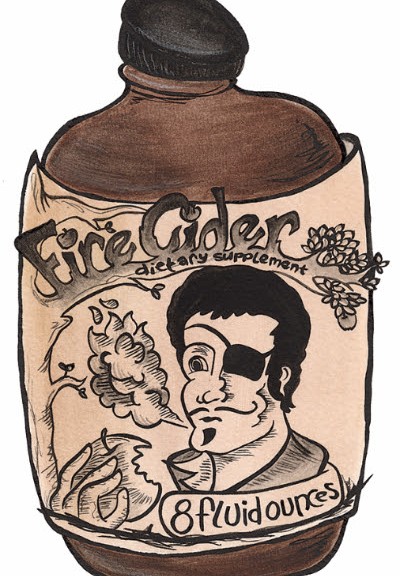For centuries grandmothers have been prescribing vinegar as a panacea for ailments ranging from hiccups to dandruff to tummy aches to arthritis. The link between vinegar and medicine is so established that the Italian word balsamico actually comes from the same origin as the word balsam in English: a resinous liquid with medicinal benefits. Perhaps, then, it should come as no surprise that when Dana St. Pierre suffered from bad allergies as a teenager, his German grandma suggested he try mixing apple cider vinegar with a bit of fresh horseradish and honey. The tonic tasted terrible—but it was effective. So effective, in fact, that he kept drinking it for years.
Over time, he tried adding in other ingredients to make it more palatable. When he lived in Phoenix he started added lemons and oranges from his backyard to the mix. But this story really begins in 2010, after Dana had moved back to his hometown of Pittsfield in western Massachusetts. That fall he made three 5-gallon jugs of hard cider. One of them went a little too hard and turned into vinegar. Dana took that vinegar and played around with a dozen recipes. After subjecting his friends to plenty of pungent taste tests, he settled on a mix of honey, horseradish, orange, lemon, onion, ginger, habanero, garlic, and turmeric. Fire Cider Vinegar was born, and it wasn’t just good for use as medicine. It earned itself a spot in the pantry.
These days, the recipe starts with unfiltered, raw, certified organic apple cider vinegar.
Dana and his team of five take that vinegar and add in the citrus, roots, and spices. Everything mixes and mingles together at ambient temperature for six weeks. Then the seasonings are filtered out and a bit of honey is mixed in. The result is a cloudy, amber vinegar that packs a serious, complex punch.
All of the ingredients in the mix are organic except for the honey. To get a honey to be certified organic, you have to be able to prove that all of the fields within the area a bee might visit for nectar are certified organic. A bee will fly up to about four miles from its hive, so that means the hive would need to be in a circle of certified organic fields that’s at least eight miles in diameter. That’s pretty uncommon in the US (or anywhere, for that matter), so to make Fire Cider Vinegar they use a local Massachusetts raw wildflower honey.
The flavor of the vinegar starts a bit sweet from the honey, then moves to a vinegary, citrusy tartness, then gets warm from the ginger, and then hot from the habanero. It tingles across the tongue and the roof of the mouth, and then tickles down the throat. The flavor lingers for a long, long time—and just when it starts to fade you realize you want to taste it again.
Five ways to rev up your cooking with Fire Cider Vinegar:
1. Whisk up a punchy vinaigrette with a peppery olive oil to dress spicy greens like arugula
2. Stir a bit into lemonade or iced tea for an afternoon pick-me-up with a kick
3. After sauteing Brussels sprouts or broccoli in a bit of bacon fat, use a splash of Fire Cider Vinegar to deglaze the pan
4. Mix some into a cool, refreshing gazpacho for just a hint of heat
5. Muddle half a jigger of Fire Cider Vinegar into a cocktail like a spicy Manhattan or a perked up Hot Toddy

